Top Wetsuits for Kiteboarding: Comfort and Ease
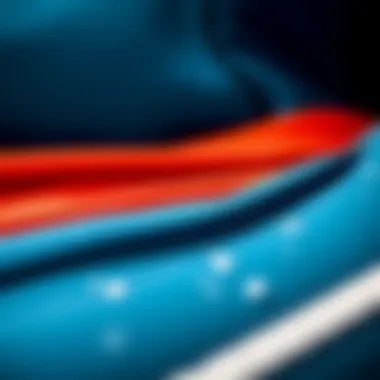
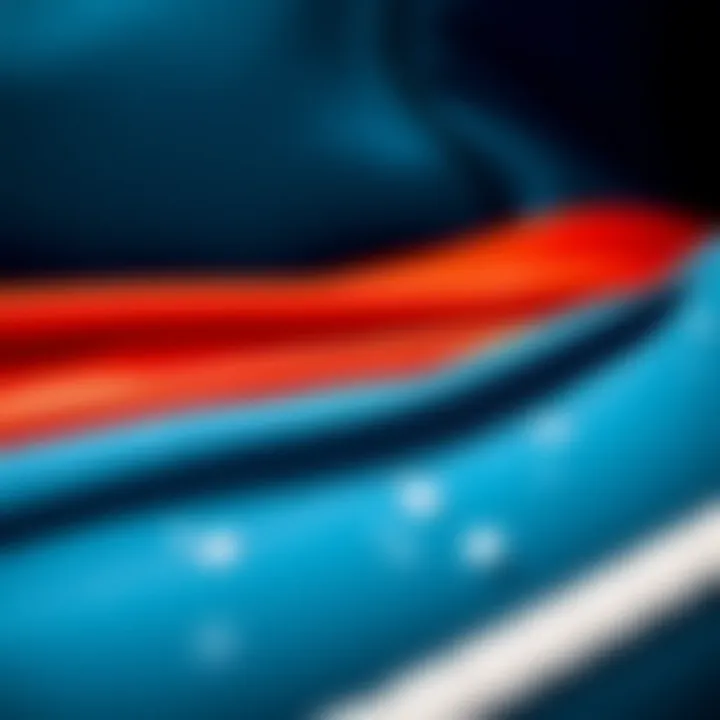
Intro
Selecting a wetsuit that truly fits your needs in kiteboarding is no small feat. It's not just about keeping warm or looking good on the water; it hinges on how accessible and comfortable the wetsuit is during your adventure on the waves. For enthusiasts, whether you're just dipping your toes or you're already a seasoned kiteboarder, understanding what makes a wetsuit user-friendly is crucial. The right wetsuit can make or break your experience, allowing you to focus on the wind and waves rather than wrestling with your gear.
This article delves into the various aspects of wetsuit selection, emphasizing ease of wear and removal—an often overlooked but vitally important feature. From innovative materials to thoughtful designs, we'll analyze how well-known brands stack up and give you the lowdown on features that really count. The goal here is not just to inform but to equip you with the knowledge to choose wisely, ensuring comfort and enhancing your kiteboarding experience.
In the sections that follow, we will explore gear insights, including the latest reviews and essential gear for newbies. Then, we will move on to techniques and tips that can help kiteboarders of all levels. Ultimately, our focus will remain firmly on how to enhance usability and performance in the water, guiding you toward that perfect fit that feels like a second skin.
Prelude
Kiteboarding is a thrilling sport that captures the essence of wind and wave, but before you hit the water, there's a critical component to consider: the wetsuit. Selecting the right wetsuit can make all the difference between a comfortable day on the water and an arduous struggle against the elements. The market is bursting with options, and each design comes with its own set of features tailored for varying conditions and levels of expertise.
When it comes to accessibility, there are pivotal elements that kiteboarders should keep in mind. A wetsuit should not only fit snugly but also allow for freedom of movement. Top-notch materials and well-thought-out designs can enhance your experience by keeping you warm while allowing you to focus on the waves rather than adjusting your gear.
Moreover, ease of wear and removal is often an afterthought until it turns into a quagmire at the beach. The last thing you want is to waste precious minutes fumbling with your gear when you could be out riding the breeze. This article unfolds the nuances of various wetsuit styles, material technologies, and user-friendly features to simplify the process of selecting the right fit.
Additionally, an exploration of reputable brands that prioritize comfort and usability is essential for making informed decisions. By the time we finish this journey, you will not only have a clearer picture of what constitutes an appropriate wetsuit, but you will also be empowered to make choices that enhance your kiteboarding experience.
In essence, this guide delivers on critical considerations for selecting accessible wetsuits, ultimately aiming for an enjoyable kiteboarding adventure where you can focus on the thrill of riding those waves.
Understanding Wetsuit Functionality
Wetsuits are crucial for kiteboarding enthusiasts. They play a key role in keeping riders warm and comfortable while out on the water. Understanding how wetsuits function helps kiteboarders choose the right suit for their needs. Whether someone is a novice or a seasoned expert, having a good grasp of wetsuit functionality can mean the difference between an enjoyable day on the water and one spent shivering and uncomfortable.
The Purpose of Wetsuits
Wetsuits are designed to provide thermal insulation and protection from the elements. The main purpose is quite straightforward: they keep you warm in cold water. When the body is immersed in water, it loses heat much quicker than in air. The wetsuit's job is to slow down this heat loss. It does this primarily through a few critical aspects:
- Insulation: Wetsuits are made of materials like neoprene, which trap a thin layer of water next to your skin. This water is warmed by your body heat, creating an insulative barrier.
- Protection: Beyond warmth, wetsuits also protect against cuts, scrapes, and stings from aquatic life. When kiteboarding, you can encounter sharp objects or marine life that could cause injury, hence a wetsuit acts as your protective armor.
- Buoyancy: The materials used in wetsuits provide some buoyancy, which can aid in floatation, beneficial in rough conditions.
Understanding these basic purposes gives kiteboarders a clearer picture of why investing time in selecting the proper wetsuit is essential.
How Wetsuits Keep You Warm
Wetsuits function based on the principle of thermal insulation. The design traps water and relies on the body to warm it up. However, there are nuances worth noting:
- Thickness matters: Wetsuits come in various thicknesses, measured in millimeters, which directly influences warmth. A 3mm wetsuit might be ideal for mild conditions, while a 5mm one is necessary for colder climates. As temperatures drop, so does the thickness of the wetsuit you may require.
- Sealed Seams: The construction quality also plays a role. Seams that are glued and blind-stitched prevent water from seeping in, ensuring that you stay warm and dry for longer periods. This can make a significant impact on comfort during extended sessions.
- Fit is crucial: A well-fitting wetsuit doesn’t just keep out water; it also minimizes the water exchange that can lead to chilling. Loose spots can allow frigid water to flow in, defeating the purpose of warmth.
Ultimately, when choosing a wetsuit, kiteboarders must consider these factors closely. The right suit will make all the difference, allowing you to focus on harnessing the wind and waves rather than shivering uncontrollably.
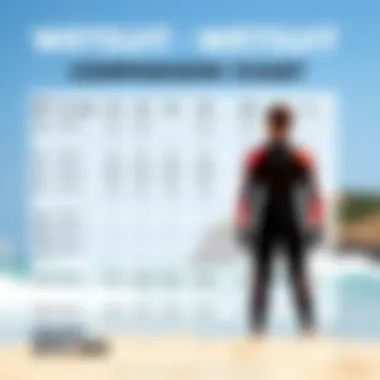

"Choosing the right wetsuit is not just about staying dry; it's about enhancing your experience in the water, keeping you comfortable and focused on your adventures."
By gaining insight into how wetsuits work, kiteboarders can make informed decisions on which suit best complements their riding style and conditions.
Key Features for Easy Wear
Selecting a wetsuit for kiteboarding often involves more than just picking a cool design; it’s about ensuring that the wetsuit is easy to wear and take off. This becomes increasingly important when you’re out on the water, where time and convenience can make a huge difference. Factors in this category not only enhance usability but also contribute to your overall experience while kiteboarding. A wetsuit that’s cumbersome can take the enjoyment out of your adventure. Therefore, knowing the features that provide ease of wear is essential for both novice and seasoned kiteboarders.
Zipper Types: Pros and Cons
Zippers on wetsuits might seem like a trivial detail, but they play a significant role in usability. Each type of zipper can affect how easily you can don and doff the suit, as well as the comfort level once it’s on. The back zipper, for instance, has traditionally been the go-to choice for many water sports enthusiasts. However, variations like the chest zip or front zip designs cater to different preferences and requirements.
When selecting a wetsuit, considering these zipper types and their functionalities is crucial. It’s like picking the right tool for a job; the wrong zipper can lead to frustration.
Wetsuit Entry Systems
Back Zip
The back zip wetsuit features a zipper placed at the rear, which allows for easy entry when sliding into the suit. One key characteristic of the back zip is its accessibility; even individuals who are not particularly flexible can typically get in without much struggle. It’s a popular choice as it’s straightforward, making it an appealing option for many kiteboarding enthusiasts.
However, the downside could be that water might seep in through the zipper area, especially if it’s not sealed well during use. This could lead to a drop in insulation performance. For someone keen on staying warm while out, this is a consideration worth making.
Chest Zip
The chest zip wetsuit presents a different take, with the zipper positioned on the chest. This unique style offers superior water sealing compared to back zips, making it a beneficial option if you're concerned about cold water intrusion. A notable advantage is its snug fit. It often hugs the body more closely, minimizing movement and drag while kiteboarding. This feature can be a game changer when you’re zipping through the waves, enhancing your performance.
However, it’s important to note that entry can be trickier, especially for first-timers. That could lead to some trial-and-error as you learn to maneuver effectively.
Front Zip
Finally, the front zip offers a unique entry system ideal for those who appreciate versatility. This zipper is placed along the front side, making it easy to slip in and adjust the tightness as necessary. The flexibility it affords allows for a broader range of motion, which can be handy when navigating tricky waters.
Its primary downside may come from the fact that this design can compromise insulation, particularly around the neck area, where water can enter more easily. Still, many aficionados swear by it for its comfort and ease of wear.
Material Recommendations for Usability
Material is another keystone feature when selecting a wetsuit optimized for ease of wear. Look for neoprene blends that prioritize flexibility while still providing warmth. A high-quality wetsuit should offer a blend of both stretch and durability. Thinner materials may allow for free movement but might compromise warmth. Conversely, thicker suits can feel restrictive.
Choosing the right material involves understanding your needs, such as the water temperature and the intensity of your sessions. Consider a wetsuit that incorporates lightweight lining and thermal properties for added comfort.
While considering wetsuit options, don’t forget the importance of maintaining your wetsuit. Caring for the materials correctly extends their lifespan and keeps your gear fresh.
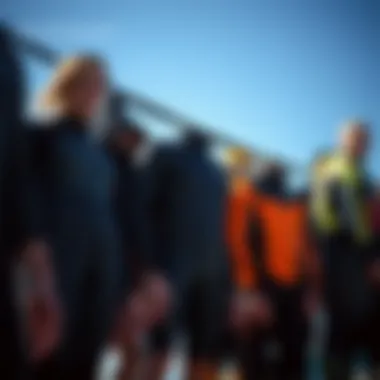

Top Brands for User-Friendly Wetsuits
When diving into the world of kiteboarding, the choice of wetsuit plays a pivotal role in one's experience. The right wetsuit not only enhances comfort but also provides a sense of freedom, allowing kiteboarders to focus on their performance rather than struggles with their gear. Consequently, selecting user-friendly wetsuits from reputable brands can truly augment your time on the water.
Many kiteboarders may find themselves overwhelmed by the abundance of options available on the market today. Skeptical about durability, flexibility, and warmth, they often find themselves standing at the crossroads of choice. That's where top brands step in, offering unique features that cater specifically to kiteboarding enthusiasts. Here, we delve into three standout brands known for their user-oriented wetsuit designs, each contributing distinct advantages.
Brand A: Design and Comfort
When it comes to standing out in the crowd, Brand A leads with exceptional design intertwined with unmatched comfort. For instance, their wetsuits use superior neoprene materials that are not only high-stretch but also lightweight. This means less bulk and more mobility for the rider, which is crucial when navigating through waves and performing tricks.
Another noteworthy aspect is the ergonomic design; their wetsuits contour to the body, offering a supportive yet unrestricted fit. Many users have noted that even after extended periods in the water, they have remained comfortable and mobile. Features such as sealed seams also add to the overall performance by reducing water entry, thus keeping the wearer warm longer.
“A solid wetsuit can feel like a second skin, enhancing both confidence and performance on the water.”
Brand B: Innovation in Ease of Use
Brand B has made a name for itself with its innovative approach to wetsuit technology. By focusing on ease of use, they have introduced unique entry systems that make wearing and removing the wetsuit a breeze. With intuitive zippers and regular fittings, these wetsuits can be donned quickly, which proves invaluable especially in dynamic environments like kiteboarding.
Additionally, allow for making a quick escape when you get back from a ride. Their designs integrate smart features, such as adjustable necklines that prevent chafing and facilitate comfort in various conditions. Without a doubt, the innovations of Brand B put them a step ahead in creating products that cater directly to the needs of kiteboarders, emphasizing satisfaction and performance above all.
Brand C: Versatile Options Available
For those who value versatility, Brand C stands out as an excellent choice. They're known for offering a wide array of wetsuit styles suitable for different weather conditions, water temperatures, and personal preferences. Whether you’re in chillier waters or enjoying a sunny day, you’re bound to find a suitable option among their extensive catalogue.
But it doesn't stop there. This brand also takes customization to a higher level. With options for thickness, cut, and even specific designs, kiteboarders can find a wetsuit that complements their unique style and needs. Users appreciate the variety which helps in matching the wetsuit not only to the conditions but also to individual tastes and riding styles.
In essence, these brands contribute significantly to the world of wetsuits by emphasizing aspects that enhance user experience. From comfort in design to innovative technologies that prioritize ease, and versatility in selection, choosing a wetsuit requires considering more than just its function. It’s all about feeling empowered out there on the water, ready to tackle whatever comes your way.
Personal Fit and Sizing Considerations
Getting the right fit when it comes to wetsuits can make or break your kiteboarding experience. The discomfort of a wetsuit that is too tight or too loose can distract you from fully enjoying the waves and wind. That’s why understanding personal fit and sizing considerations is crucial. A well-fitting wetsuit ensures not just comfort but also optimal performance, allowing for greater mobility and warmth in cooler waters. The right fit often translates to a better experience on the water, which is why this section deserves close attention.
Importance of Accurate Measurements
To choose the best wetsuit, it begins with accurate measurements. Taking the time to measure yourself properly can save you from unnecessary headaches later. It’s not just about height and weight; you should often account for your chest, waist, and hip sizes as well. Here’s why these measurements matter:
- Precision: A wetsuit that fits like a glove minimizes water entry, keeping you warmer.
- Flexibility: When a wetsuit fits properly, it provides better flexibility for your movements. This can be especially important for tricks and turns in kiteboarding.
- Safety: An overly loose wetsuit can lead to chafing, which can be a nasty distraction when you’re out there riding.
In many cases, following the manufacturer's sizing chart helps a lot. It can be tempting to buy a smaller size for a snugger fit, but this can backfire and restrict movement. Remember, comfort on the water is paramount!
Adjustable Features for Optimal Fit
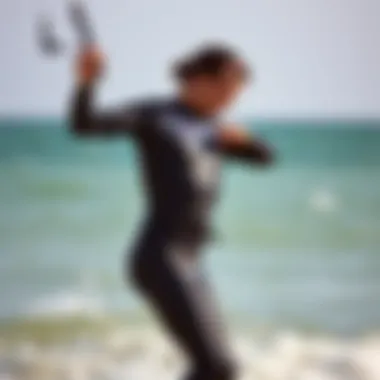
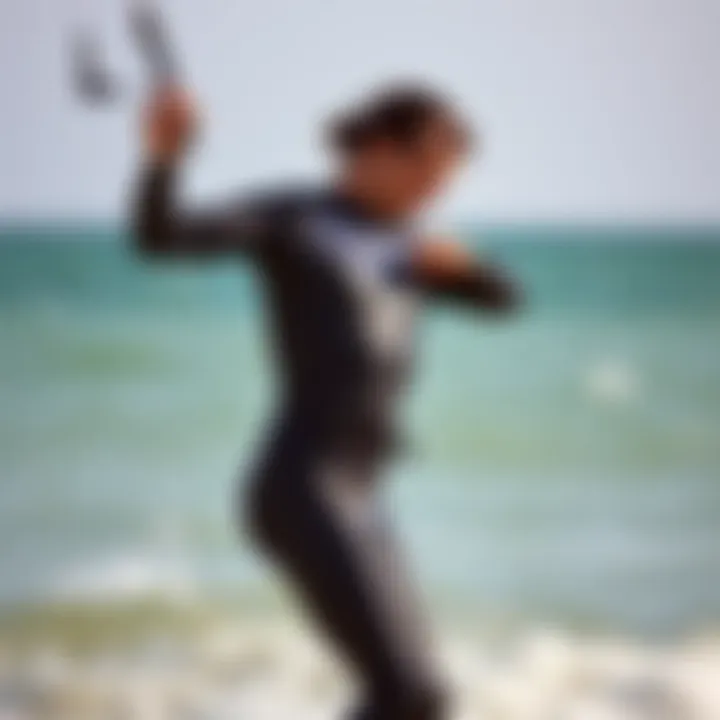
Even with the best measurements, body shapes can vary significantly. Here’s where adjustable features come into play to enhance the fit of your wetsuit:
- Velcro Straps: Some wetsuits come with adjustable straps around the waist or ankles, allowing you to customize how snugly they fit.
- Removable Panels: A few modern designs add panels that can be adjusted or removed for a more personalized fit. This kind of flexibility can adapt to changing body shapes, too.
- Knee Pads: Good wetsuits often include adjustable knee pads, ensuring you have extra comfort during those long sessions.
Having adjustable features turns a good wetsuit into a great wetsuit. They help you not just grab the right size but also lock in your personal preferences. Comfort should never be a compromise, especially when gliding over water serves as both adrenaline and relaxation.
Selecting a wetsuit that allows you to adjust features can truly elevate your kiteboarding sessions. It’s all about finding that sweet spot where comfort meets usability.
In summary, personal fit and sizing considerations are foundational components of your wetsuit selection. Investing time in measuring correctly and understanding adjustable features will ensure you’re well-prepared for your next kiteboarding adventure.
Maintenance of Wetsuits for Longevity and Freshness
Keeping your wetsuit in top-notch condition is crucial for kiteboarding enthusiasts who want to enjoy their aquatic adventures without interruption. Proper maintenance not only extends the lifespan of the wetsuit but also ensures that it performs at its best. A well-cared-for wetsuit provides optimal insulation, flexibility, and comfort, which are essential whether you’re carving waves or gliding over the water.
Cleaning and Care
Taking care of your wetsuit starts with cleaning. After every kiteboarding session, it’s a good practice to rinse your wetsuit in cold, fresh water. Saltwater, sand, and other debris can seep into the fabric, potentially causing damage over time. Here are some steps to follow for effective cleaning:
- Rinse Immediately: As soon as you step off the water, rinse your wetsuit inside and out. This removes salt and sand that can wear down the material.
- Use Mild Soap: Occasionally, use a gentle wetsuit cleaner or a mild soap when rinsing. Harsh detergents can deteriorate neoprene fabrics.
- Avoid Hot Water: Hot water can damage the neoprene. Stick to cold or lukewarm water only.
After rinsing, hang your wetsuit to dry in a shady, well-ventilated area. Direct sunlight can degrade the material, causing it to lose elasticity and strength.
Remember: Treat your wetsuit like an investment! Proper cleaning will not only keep it fresh but also save you from unnecessary purchases down the line.
Storing Your Wetsuit Properly
Once your wetsuit is cleaned, how you store it is equally important. If you throw it in the corner of your garage or leave it crumpled up, you’re setting yourself up for disappointment. Here's how to store it right:
- Use a Hanger: Hang your wetsuit on a wide hanger to prevent deforming the shoulders. Make sure the hanger has a smooth surface to avoid creating creases.
- Avoid Folding: If you must fold it, do so at the knees rather than across the arms or torso, to prevent pressure lines that can crack the material.
- Cool, Dry Location: Store your wetsuit in a cool, dry place away from direct sunlight or heat sources.
By following these guidelines for both cleaning and storing, you’ll extend the life of your wetsuit and keep it looking good as new. This means more time on your board and less on dealing with gear problems.
End
Selecting the right wetsuit for kiteboarding transcends mere preference; it’s about optimizing both performance and comfort on the water. As this article illustrates, understanding the functionality and features of wetsuits allows kiteboarders to make informed choices, ensuring an enjoyable experience whether one is just starting out or has years of wind and waves under their belt.
First, the emphasis on easy wear and removal cannot be overstated. Wetsuits with intuitive entry systems—like front zip options or back zippers—enhance user experience, making the transition from land to sea seamless. This is particularly vital in kiteboarding, where time spent fumbling with gear can result in missed opportunities for catching wind, not to mention the annoyance of battling a stuck zipper.
Moreover, the materials used in constructing wetsuits have evolved dramatically. The shift towards lighter, stretchier, and more durable materials has dramatically improved comfort. When kiteboarders feel relaxed in their wetsuits, they can focus on the thrill of riding the waves rather than on discomfort.
In addition, personal fit is paramount. No one wants a suit that’s too tight or too loose; not only does it impair performance, but it can also lead to frustration mid-session. Hence, understanding sizing nuances and the adaptability of wetsuit features—like adjustable collars or ankle seals—can profoundly impact overall satisfaction.
Finally, maintenance practices highlighted throughout the article play a pivotal role in extending the life and performance of a wetsuit. Simple, routine care techniques ensure the suit remains in top condition, ready to face any kiteboarding adventure.
"A well-maintained wetsuit lasts longer, keeps its insulation properties intact, and provides you with a better overall experience on the water."
By synthesizing the information presented, it’s clear that selecting the right wetsuit isn't an endeavor to be taken lightly. It plays a crucial role in enhancing kiteboarding adventures, ensuring that enthusiasts can enjoy the open water without the hindrance of ill-fitting or poorly maintained gear. In the end, the right wetsuit isn’t just a piece of equipment; it’s part of the kiteboarding journey itself.















